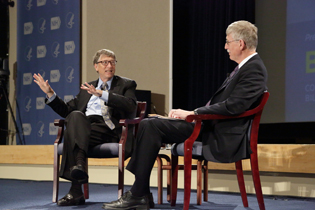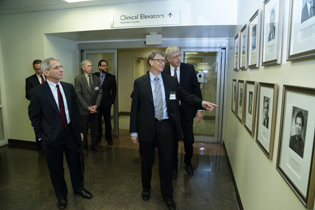Bill Gates Asks NIH Scientists for Help in Saving Lives
And Explains Why the Future Depends on Biomedical Innovation

BILL BRANSON
Microsoft co-founder Bill Gates (left) visited NIH recently to tour labs, meet with institute directors, and deliver a lecture on “Why the Future Needs Biomedical Intervention,” in which he thanked NIH for partnering with the Bill and Melinda Gates Foundation in projects that address poor health in developing countries. NIH and the Gates Foundation together provide more than half of all global-health research funding. After the talk, NIH Director Francis Collins (right) asked Gates questions that had been posed by NIHers.
“One of the makers of our modern world.” A “visionary” in global health with “the energy and perseverance … to transform the world.”
NIH Director Francis Collins was describing Superhero … err … global-health philanthropist Bill Gates, who co-founded Microsoft and the Bill and Melinda Gates Foundation. Gates visited NIH’s Bethesda campus on December 2, 2013, to tour research labs, meet with institute directors, and deliver the David E. Barmes Global Health Lecture, “Why the Future Needs Biomedical Intervention.”
The Gates Foundation, which was established in 2000 and has donated some $28 billion for projects that include addressing extreme poverty and poor health in developing countries, “stands as a leader in the fight against many of the world’s leading causes of death and disability,” said Collins in introducing Gates at the lecture. “In fact, [it has] transformed our approach to global health.”
NIH and the Gates Foundation together represent 57 percent of all funding for global-health research and development on diseases that disproportionately affect populations in low-and middle-income countries, according to NIH’s Fogarty International Center: NIH supports 40 percent and the Foundation supports about 17 percent.
“I want to thank you for your partnership in many things that we do together,” Gates told the crowd that had packed into Masur Auditorium. “It's a very broad partnership, touching a lot of your different institutes, [that] is growing over time.”
NIH and the Gates Foundation are working together on many projects including determining enteric disease risk associated with malnutrition; developing HIV and malaria vaccines as well as innovative tuberculosis therapeutics; assessing the population effects of anti-retroviral therapy to reduce HIV transmission; developing nutritional biomarkers; understanding iron and malaria interactions; and more.
The Gates Foundation also focuses on providing vaccines to children in poor countries. Around the time Gates and his wife, Melinda, were establishing their foundation, they were astounded to learn that 250,000 children died each year of rotavirus, a diarrheal disease, even though a vaccine existed to prevent it. Only wealthy countries, however, could afford it. The foundation wanted to make that vaccine—and others—available and affordable to poor countries, too.
Vaccines for rotavirus as well as for measles, meningitis, and the pentavalent vaccine (which provides protection against diphtheria-tetanus-pertussis, hepatitis B, and Haemophilus influenzae type b) provide cost-effective and lasting protection against disease and are key tools for saving lives.
“A lot of [the] rotavirus constructs were created at NIH,” Gates noted. He also cited the contributions of NIH intramural scientists John Robbins and Rachel Schneerson, who developed a vaccine to eradicate bacterial meningitis caused by Haemophilus influenzae type b. Robbins and Schneerson won the Lasker Award in 1996 for what the Lasker Foundation described as their “groundbreaking work and bold, visionary and imaginative leadership in the development and commercialization of the Haemophilus influenzae type b vaccine and bringing the vaccine to market, leading to the eradication of Haemophilus influenzae type b, typhoid, and pneumococcus.”

ERNIE BRANSON
NIH Director Francis Collins (right) showed Bill Gates (center) the photos of NIH’s Lasker winners while NIAID Director Anthony Fauci (also a Lasker winner) looks on.
“The effect of these vaccines is truly miraculous,” said Gates. The Gates Foundation helps provide vaccines at tiered pricing so children in poor countries can receive them at marginal costs. “Over time, the cost of making most vaccines will get down to something like 20 or 25 cents per child treated and yet it can give you lifelong protection.
“To achieve the [foundation’s] ambitious goals, we need your help,” Gates continued. He acknowledged that developing vaccines is tough, especially for diseases such as human immunodeficiency virus (HIV) for which there is no natural immunity. Developing an HIV vaccine has been an important but elusive goal for both the foundation and NIH. “I’m certainly optimistic that we will get an HIV vaccine, although you couldn’t give a timeframe for it.” He lauded the “quite phenomenal” contributions by NIH intramural researchers in characterizing antibodies to HIV.
Another “very promising area” of intramural research is viral-based vaccine constructs that convert host cells into “a factory” of disease-fighting antibodies, enabling “protection more rapidly than natural immunity,” Gates said. He was “thrilled” that NIH researchers “are pushing [vaccine research] forward.”
Still, Gates expressed disappointment that U.S. funding for global health is dwindling even though funding from other countries is increasing. “Investing in research has huge paybacks in improving the human condition [and] in reducing health costs,” he said. “I am an optimist. I think we’ll be able to convince people that those investments should be restored and grow.”
“It’s really the kind of basic science work that you do that’s made all of this [work] possible,” Gates said. “We are just at the beginning of what we can do together.”
The annual David E. Barmes Global Health Lecture was established in 2001 to honor the late David Edward Barmes, an ardent and lifelong supporter of global health. A special expert for international health at the National Institute of Dental and Craniofacial Research (NIDCR) and a longstanding World Health Organization employee, Barmes devoted his life to research aimed at improving health for people in low-income countries. This annual lecture is sponsored by NIDCR and the Fogarty International Center; a videocast of the Gates lecture, “Why the Future Needs Biomedical Intervention,” may be viewed at http://videocast.nih.gov/launch.asp?18190.
This page was last updated on Wednesday, April 27, 2022
